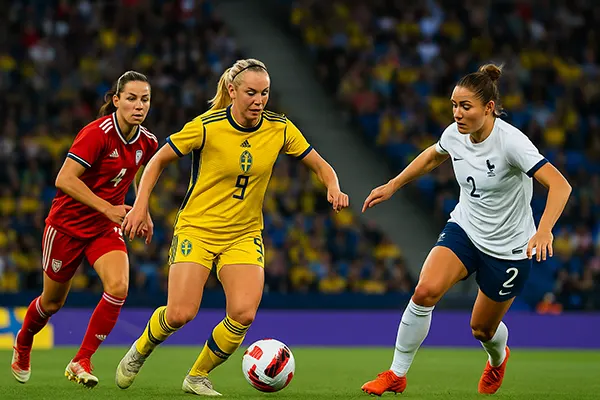The UEFA Women’s EURO 2025 has become one of the most significant turning points in modern women’s football. The tournament, hosted across Switzerland, not only attracted unprecedented global attention but also introduced structural, financial and strategic changes that reshaped the balance of power among national teams. By 2025, the women’s game experienced rapid professional growth, and the championship highlighted deeper competitiveness, investment shifts, and improved player development systems.
Expanded Resources and Strategic Investment in Women’s Football
One of the defining outcomes of the 2025 championship was the accelerated investment from national federations and private partners. Countries that previously occupied secondary positions began to fund youth academies, scouting networks and specialised training programmes. This raised the overall standard of play and reduced the traditional gap between established contenders and emerging teams.
Switzerland’s hosting model also demonstrated how modern infrastructure and well-organised logistics support competitive fairness. Stadium upgrades, technological improvements and enhanced medical facilities contributed to better match quality and player safety. These advancements motivated other European associations to upgrade their own systems after witnessing tangible results.
As a result, investment patterns shifted notably. Federations in Eastern and Northern Europe increased budget allocations for women’s national programmes, emphasising domestic league development. This created new rivalries and strengthened mid-tier teams that had long been overshadowed by dominant nations.
Impact of Financial Growth on Team Performance
The tournament clearly illustrated that long-term financial support translates directly into competitive results. Nations that implemented multi-year development strategies prior to 2025 displayed greater tactical flexibility, deeper squads and improved endurance during high-intensity matches. This contrasted with teams that relied solely on individual talent rather than system-based growth.
Enhanced financial support also encouraged clubs across Europe to raise salaries, offer full-time contracts and invest in specialised coaching staff. Such improvements allowed players to train under better conditions and focus entirely on their professional careers. The result was a more balanced playing field at the EURO, where several matches were decided by marginal details rather than overwhelming superiority.
In addition, improved financial stability contributed to better sports science integration. Teams prioritised data-driven training, injury prevention and psychological preparation. These changes helped level the competition between historically strong nations and those climbing the hierarchy.
Rise of New Contenders and Tactical Evolution
UEFA Women’s EURO 2025 showcased the emergence of national teams that had rarely reached advanced stages in previous tournaments. Nations such as Austria, Belgium and Iceland demonstrated significant tactical evolution, relying on structured pressing, versatility and modern positional play. Their progress reshaped the traditional power distribution, challenging the dominance once held exclusively by Germany, England, France and the Netherlands.
Coaching methodologies played a central role in this shift. Federations prioritised advanced licensing programmes, analytical departments and collaborative networks with domestic clubs. As a result, coaches approached the competition with clearer tactical identities and more innovative strategies based on detailed opponent analysis.
The levelling of tactical sophistication also meant that established favourites could no longer rely on historical authority. The tournament included multiple unpredictable results, underscoring the increased competitiveness across all groups and knockout stages.
How Tactical Diversity Changed the Tournament
The 2025 EURO delivered a broader tactical spectrum than any previous edition. Teams employed varied formations, including fluid back-three systems, hybrid midfield structures and adaptive forward pressing. This tactical diversity forced even the strongest sides to modify their strategies during matches instead of relying on pre-set formulas.
Moreover, analytics departments provided real-time insights on opposition tendencies. Coaches used this information to adjust defensive lines, modify transitional patterns and counter specific match-ups. Such tactical responsiveness created more dynamic games and fewer one-sided fixtures.
The evolution also influenced player development pathways. Young athletes were trained to operate in multiple roles instead of specialising early, creating more adaptable and tactically intelligent squads by the time of the tournament.

Global Visibility and Its Influence on European Dynamics
The 2025 championship set new broadcasting records, strengthening the commercial value of the women’s game. Wider visibility encouraged additional sponsors to enter the market, redistributing financial opportunities across more federations. This shift reduced reliance on traditional powerhouse nations and allowed smaller associations to expand their international presence.
Increased media attention also influenced public perception. The visibility of underdog teams inspired greater participation at grassroots levels. More young players joined local academies, improving the long-term talent pool and strengthening the competitive balance among national teams.
The broader global exposure led to new collaborations between European federations and international partners. Joint training camps, exchange programmes and cross-league partnerships became more common, widening development opportunities and helping nations refine their competitive standards.
Long-Term Effects on Player Pathways and Competitiveness
As interest in the tournament grew worldwide, European clubs began to attract higher numbers of young talents from abroad while also investing in domestic prospects. This created a more competitive environment within clubs, indirectly strengthening national programmes. Greater squad depth translated into more balanced international match-ups.
Media coverage also amplified player recognition, giving athletes stronger individual profiles and encouraging more structured career support from federations. The improved visibility pushed national associations to establish clear development roadmaps for youth and senior teams.
Ultimately, the rise in talent mobility, international cooperation and visible role models contributed to a more evenly distributed competitive structure across European football. These long-term impacts are expected to continue influencing the hierarchy well beyond the 2025 tournament.
